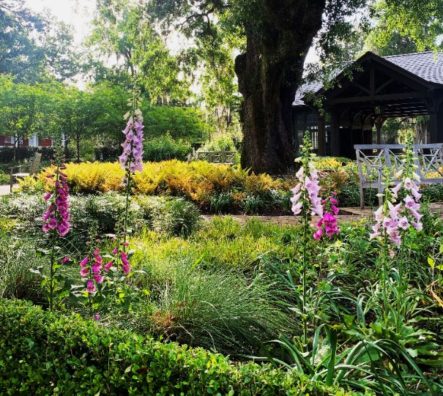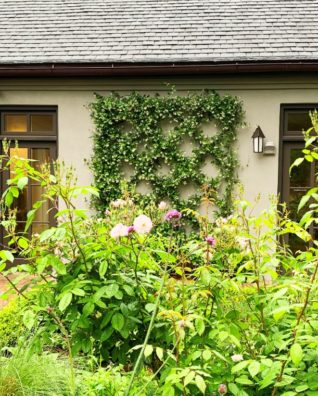Voted the Best Place to See by Condé Nast Traveler.


April 29, 2021 – Digitalis (Foxgloves) in bloom in the Lenhardt Garden.
Spring is gently nursing the plants to success in the Lenhardt Garden at Drayton Hall; On many accounts, it was well worth the wait.
Once again this year, the reliable blooms of two plants are particularly impressive. One, Digitalis purpurea – the foxglove – are reaching peak stage with their tall spikes of blush and rose blooms. The other is the energetic, floriferous, and fragrant Noisette rose, Champney’s Pink Cluster.
Based on his diaries (1784 – 1820), Dr. Charles Drayton sought foxgloves in a listing from the Eighteen-teens. Not only are these beautiful flowers, but they were used by doctors in Drayton’s time for medicinal purposes. Charles obtained prices for these, along with an assortment of other plants, provided in list form by Charles Whitlow. Whitlow was himself a fascinating character ahead of his time, known for lecturing on botanical and agricultural topics. In 1812, Whitlow petitioned Congress for a plot of land in Washington D.C. to establish a botanical garden. This effort did not find support among many, including Thomas Jefferson, and the petition was ultimately withdrawn. As for Charles Drayton’s foxgloves and other plants, they appear to be items sold by the Landreth Seed Company of Philadelphia founded in 1787. Charles Whitlow had links with Landreth Seed on occasion and nearly all of Charles Drayton’s particular plants match those in The Landreth Catalogue published in 1811.
Our other garden plant racing into bloom at the moment is Champneys Pink Cluster rose. This, the first of the Noisette roses, is well-suited for our garden as it was developed in Charleston and is at home here. Champneys Pink Cluster rose is a hybrid cross of Rosa chinensis ‘Old Blush’ a China rose and Rosa moschata, the Musk rose. This union was blended and grown in the gardens of John Champneys (1743-1820) who provided Philippe Noisette with the rose. Philippe sent the rose plant and/or seeds on to his brother Louis in France, which he used to produce Noisette rose hybirds. Charles Drayton writes on October 19, 1813 of his visit to Champneys in Charleston. Interestingly, what grabs Drayton’s attention is not roses, but the particular methods Champneys used in producing “excellent” and “large and abundant” tomatoes.
The Foxgloves – digitalis – will only be around another week while the Champneys rose will continue to bloom until a very hard freeze with periodic encouragement with moderate pruning. This week is the perfect time to visit the Lenhardt Garden to see an abundant and spectacular spring show of bloom and color!
-Eric Becker
Manager of Landscapes, Horticulture, and Modern Facilities

April 29, 2021 – Champneys Pink Cluster roses and jasmine in bloom in the Lenhardt Garden.